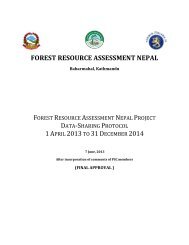Download - FRA Nepal
Download - FRA Nepal
Download - FRA Nepal
You also want an ePaper? Increase the reach of your titles
YUMPU automatically turns print PDFs into web optimized ePapers that Google loves.
7.2.1.6 Output and timetable<br />
Duty / Product<br />
Timetable<br />
The design of the questionnaire form and interview outline 1 st quarter of the 1 st year<br />
Identification of the interested organizations, parties and various stakeholders 1 st quarter of the 1 st year<br />
Revealing the data needs by disseminating the questionnaires, carrying out interviews, 1 st quarter of the 1 st year<br />
etc. The various existing data sources should be examined in this part of the<br />
implementation.<br />
Analysis of the results of the data needs assessment including the existing data sources 1 st trimester of the 1 st<br />
year<br />
Defining the variables to be covered by National Forest Resource Assessment 1 st half of the 1 st year<br />
A report will be written outlining shortly the further forest resource assessments to<br />
cover the remaining specific data needs beyond capabilities of <strong>FRA</strong>. Report published.<br />
1 st half of the 1 st year<br />
The main output above is the definition of the <strong>FRA</strong> variables. One of the key results is the definition of forest and shrub land,<br />
which should be in line with the international requirements of the FAO and IPCC. The data needs assessment must be carried<br />
out during the first four months of the project. A short report presenting the main results would be beneficial for future<br />
purposes.<br />
The project staffs responsible for implementation:<br />
Chief Technical Advisor and National Project Coordinator with help of other specialists are responsible.<br />
7.2.2 Ground sampling<br />
7.2.2.1 Practical arrangements<br />
The field inventory is the most important functions of <strong>FRA</strong> for generating forest resource data. However, ground sampling is<br />
very precarious in the <strong>Nepal</strong>ese context due to difficult terrain, remoteness, labor intensive and very expensive. Thus, this<br />
work cannot be handled by DFRS staff alone. So the project aims to decentralize the field inventory to the district level<br />
forest organizations. Besides, outsourcing of manpower from NGOs, CBOs, academic institutions and consulting companies<br />
will be another strategy to increase the efficiency and effectiveness of ground inventory. The technical team and DFRS staff<br />
will take responsibilities for conducting training, controlling and monitoring of ground based forest inventory. The<br />
possibilities for the outsourcing of the field work with the following organizations will be assessed.<br />
<br />
<br />
<br />
<br />
The staff of District Forest Offices ( arrangement will be made by the Project Steering Committee)<br />
Advanced level students (from the Institute of Forestry), who will commit to work for several months in the<br />
field<br />
Community forest user groups will also be used to collect data on the decision of the Project Steering<br />
Committee)<br />
Private consulting companies and other entrepreneurs.<br />
The field work manual of 1995 will be reviewed and revised to meet the needs of the current <strong>FRA</strong>. A training session for all<br />
of the field inventory crews will be planned and implemented. Field work can be organized in spring (mid January to end of<br />
May) and autumn (mid September to mid December). Months from June to August are hot and rainy. Many areas are not<br />
accessible at that time and frequent heavy rains make the field work very difficult. October is a month of Dasain and Tihar<br />
festivals (around 3 weeks), which are socially very important and people are not willing to travel on that time. By analyzing<br />
the physiographic and seasonal variances and socio cultural dimensions the project will make yearly plan for field inventory<br />
work.<br />
To cover the whole country more than 400 clusters should be measured in the field in two and half years’ time. This equals to<br />
600 crew weeks of field inventory in total, 240 crew weeks per year. As annual field work season is around 28-30 weeks 10<br />
crews are needed to implement the <strong>FRA</strong> and additional measurements for biodiversity, TOFs and NTFPs in total three years’<br />
time. In addition, at least one extra inventory crew (control crew) is needed for quality verification measurements.<br />
It is recommended to proceed work region-wise. This would result in annual reporting of the results and providing the end<br />
users with information and showing the initial trend of development concerning the whole country. The work could be started<br />
25





